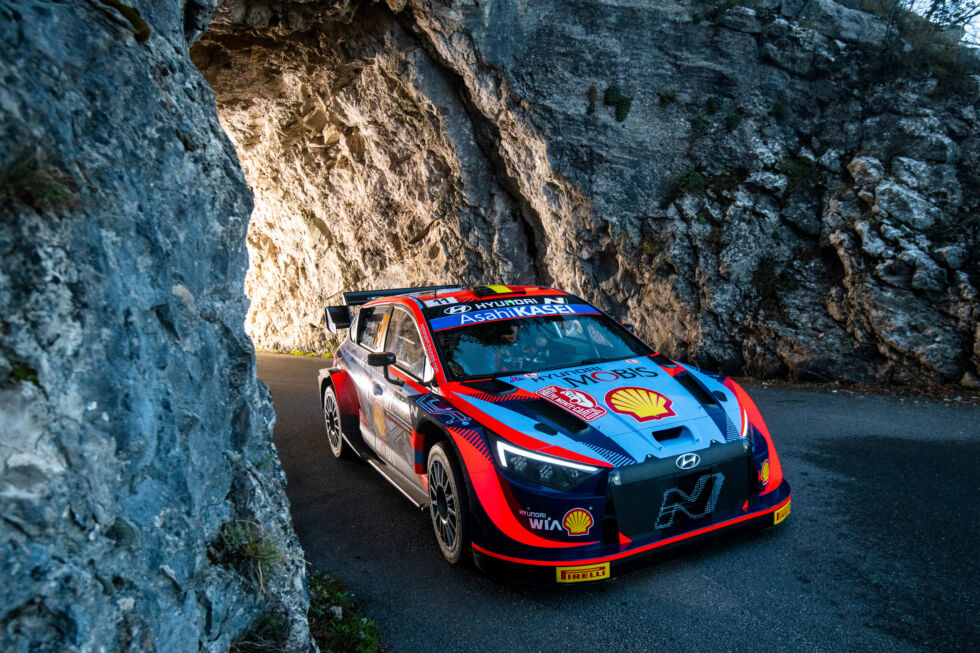Meet 2022’s World Rally cars: Much more power, much more sustainable

The 2022 World Rally Championship got underway on Thursday with the first night stages of the Monte Carlo Rally. It’s a year of big change in the WRC with the introduction of all-new Rally1 cars—the most powerful vehicles to compete in the sport since the demise of the flame-spitting Group B cars in 1986.
For some time, WRC cars have used turbocharged four-cylinder 1.6 L engines, and that standard continues for Rally1. The engines drive the front and rear wheels via prop shafts and differentials, as you might expect, but there’s no center differential between the front and rear axles, just a fixed 50:50 distribution of torque front to rear.
And the engine isn’t the only thing that sends power and torque to the rear differential; there’s now a hybrid unit behind the fuel tank that has its own shaft to that differential. This is a spec component, supplied to all the teams by Compact Dynamics, a subsidiary of Schaeffler, which worked closely with Audi’s Formula E program.

Compact Dynamics makes the 134 hp (100 kW), 132 lb-ft (180 Nm) motor-generator and the inverter, and Kreisel Electric provides the 3.9 kWh lithium-ion battery pack. Together, the parts give a 2022 WRC Rally1 car roughly 500 hp (372 kW) and 369 lb-ft (500 Nm), at least for short bursts of up to three seconds at a time. But drivers are required to recover 30 kJ of energy via regenerative braking between hybrid boosts. (Recharging the battery packs at a service stage takes about 30 minutes.)
On top of that, the Rally1 cars need to complete certain (not timed) road sections using just electric power.
WRC has also switched to a fully sustainable fuel provided by P1 Racing Fuels for the next three years. It’s a drop-in fuel—meaning the engines didn’t need any work to use it compared to last year’s more conventional gasoline—and is a blend of biofuel and synthetic fuel.
However, the 2022 World Rally-spec Ford Puma, Toyota GR Yaris, and Hyundai i20 N no longer start life as bodyshells on the usual production lines for those cars. Instead, like a stock car in NASCAR, a Rally1 car begins with a steel spaceframe chassis built to FIA specifications. (The FIA, or Fédération Internationale de l’Automobile is the governing body for world motorsport.)

There’s a double roll hoop for the occupants, and the hybrid unit and fuel tank are both in the roll cage as well. According to the FIA’s tests, a Rally1 car is able to absorb far more energy in a crash than the old cars—up to 115 percent more for the roof section, with a 51 percent reduction in side intrusions and 70 percent less intrusion following a frontal impact.
However, the cars have gained some weight as a result of all this new tech—about 154 lbs (70 kg) more than last year, meaning a Rally1 car will tip the scales at about 2,778 lbs (1,260 kg).
So far, Rally Monte Carlo has been dominated by the two French Sebastians, nine-time champion Sebastian Loeb (driving for Ford, with Isabelle Galmiche as co-driver) and eight-time champion Sebastian Ogier (driving for Toyota, with Benjamin Veillas as co-driver), with British duo Elfyn Evans and Scott Martin in third place in another Toyota. Unfortunately for most of our readers, the only way to watch the WRC in 2022 in the US is by subscribing to WRC+, the sport’s streaming service. The Monte Carlo Rally ends this Sunday.
https://arstechnica.com/?p=1827431